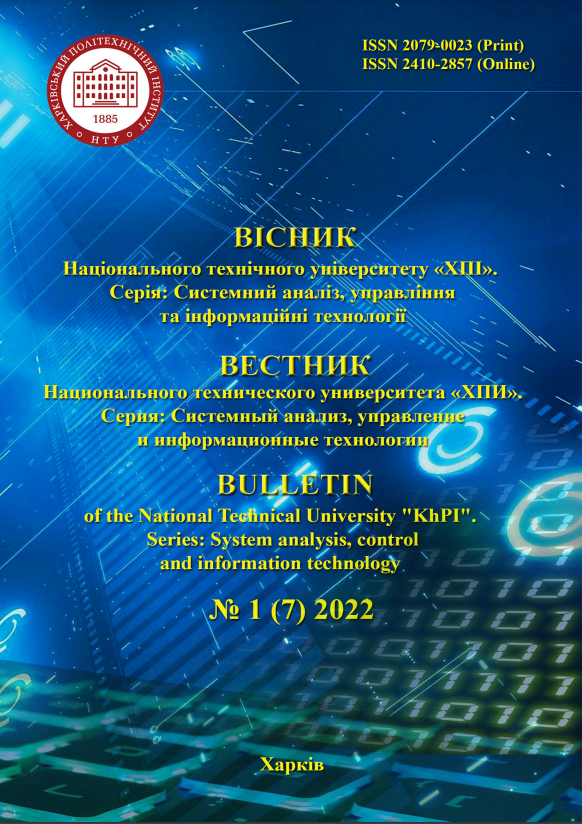A SOFTWARE SOLUTION TO WORK WITH A DATABASE OF BUSINESS PROCESS MODELS AND ANALYZE THEIR STRUCTURAL MEASURES
DOI:
https://doi.org/10.20998/2079-0023.2022.01.10Keywords:
business process model, modeling notation, structural measures, modeling guidelinesAbstract
Business process modeling is one of the main tools of the BPM (Business Process Management) concept. With the help of business process modeling, business scenarios can be presented in the form of graphical models that can be easily understood by both information technology (IT) professionals and non-IT professionals – business analysts, software customers, department heads, top managers, and other stakeholders interested in business process improvement. Business process improvement is usually done through the automation of activities, which were identified as “bottlenecks” after analysis. However, it is possible to analyze a business process model only if it is clear and correct in terms of compliance with both the notation used and the real business process it depicts. This paper considers the analysis of BPMN (Business Process Model and Notation) business process model structural measures. It is assumed that business process models, which by their structural features violate rules of business process modeling, are neither understandable nor suitable for further work with them, which also can lead to various errors occurring at the stage of business process analysis, as well as at the stage of its improvement and implementation of proposed changes, i.e., during development, testing and maintenance of distinct software components, information system modules or BPM-system scenarios that ensure business process execution. Therefore, in this paper, we propose to identify the main elements of BPMN business process models and their structural measures that affect models’ understandability and maintainability and could be sources of errors. Considering selected measures, it is proposed to calculate respective values for a large collection of BPMN business process models, and then study compliance with theoretical business process modeling guidelines on practice when real business process models are designed. In order to provide efficient storage and processing of a large collection of BPMN business process models data, there were developed a database, and a software component. Results of analysis of BPMN business process model structural measures obtained using developed database and software component are demonstrated and discussed. The conclusion is made, as well as future research directions in this field are formulated.
References
Dumas M. et al. Fundamentals of Business Process Management. Springer, 2018. 527 p.
Reijers H. A., Mendling J. A study into the factors that influence the understandability of business process models. IEEE Transactions on Systems, Man, and Cybernetics-Part A: Systems and Humans. 2010, no. 3 (41), pp. 449–462.
Ransome J., Misra A. Core Software Security: Security at the Source. CRC Press, 2018. 414 p.
Allweyer T. BPMN 2.0: Introduction to the Standard for Business Process Modeling. BoD – Books on Demand, 2016. 172 p.
Topi H., Tucker A. Computing Handbook: Information Systems and Information Technology. CRC Press, 2014. 1522 p.
Mendling J., Neumann G., van der Aalst W. On the correlation between process model metrics and errors. Australian Computer Society. 2007, pp. 173–178.
Mendling J., Sánchez-González L., García F., la Rosa M. Thresholds for error probability measures of business process models. Journal of Systems and Software. 2012, no. 5 (85), pp. 1188–1197.
Weske M., Decker G., Dumas M., La Rosa M., Mendling J., Reijers H. A. Model Collection of the Business Process Management Academic Initiative (Version BPMAI-29-10-2019) [Data set]. Available at: https://doi.org/10.5281/zenodo.3758705 (accessed 20.03.2022).
Weinberg S. L., Abramowitz S. K. Statistics Using R: An Integrative Approach. Cambridge University Press, 2020. 692 p.
Nordeen A. Learn Data Warehousing in 24 Hours. Guru99, 2020. 380 p.
Krogstie J. Quality in Business Process Modeling. Springer, 2016. 250 p.
Correlation Coefficients. Available at: https://www.andrews.edu/~calkins/math/edrm611/edrm05.htm (accessed 20.03.2022).
Downloads
Published
How to Cite
Issue
Section
License
LicenseAuthors who publish with this journal agree to the following terms:
- Authors retain copyright and grant the journal right of first publication with the work simultaneously licensed under a Creative Commons Attribution License that allows others to share the work with an acknowledgement of the work's authorship and initial publication in this journal.
- Authors are able to enter into separate, additional contractual arrangements for the non-exclusive distribution of the journal's published version of the work (e.g., post it to an institutional repository or publish it in a book), with an acknowledgement of its initial publication in this journal.
- Authors are permitted and encouraged to post their work online (e.g., in institutional repositories or on their website) prior to and during the submission process, as it can lead to productive exchanges, as well as earlier and greater citation of published work (See The Effect of Open Access).


